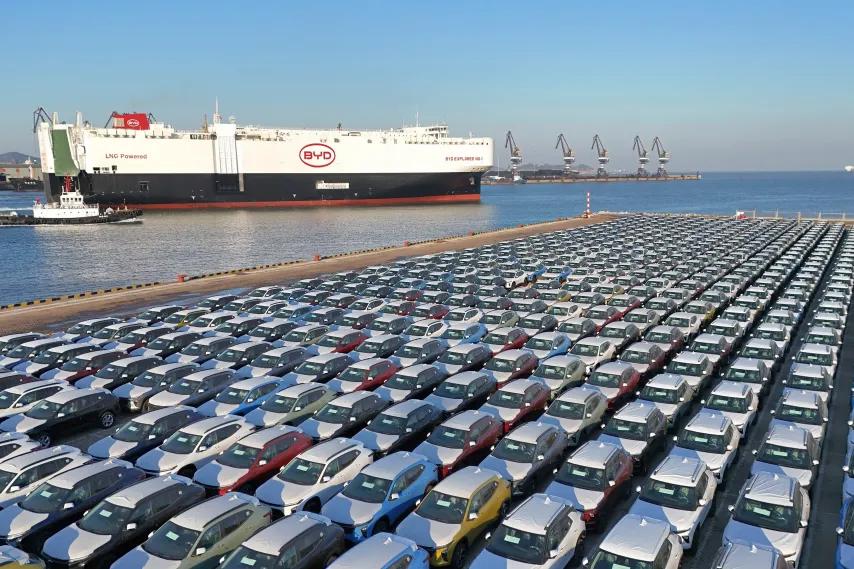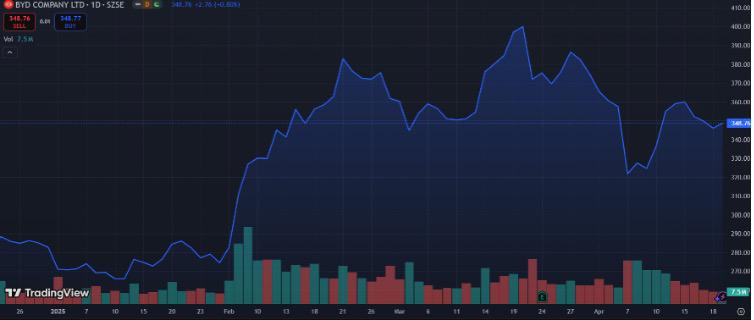The Tariff Turbulence Series: Is BYD Built to Last?
Date Written: 22nd April 2025
Introduction
In early April 2025, the share price of BYD, China’s top electric vehicle (EV) manufacturer, experienced significant market volatility. initially declining sharply before rebounding. But why did this happen?
The Decline?
Market Panic Triggered by Trump’s 60% Tariff Announcement:
- On April 2, 2025, Donald Trump announced a 60% tariff on electric vehicles from China, directly targeting the Chinese EV sector.
- This triggered a sharp global market selloff. It caused the Dow Jones to drop by 4,000 points in two days and dragged down Chinese stocks like BYD due to fears of retaliatory actions and global trade slowdown, as investors feared a new wave of trade tensions. (AP News, 2025)
China Slowdown Fears Amid Rising Trade Tensions:
- Investors feared that the tariff escalation would push China’s economy closer to recession, weakening consumer demand and harming domestic focused companies like BYD, which still relies heavily on the Chinese EV market. (Reuters, 2025)
Lingering Concerns Over Brazilian Labour Scandal
- A December 2024 scandal involving BYD's Brazilian contractor came back into the spotlight. The contractor was accused of exploiting Chinese workers at a plant construction site. Even though BYD cut ties with the firm, the issue created reputational concerns as BYD expands globally. (Associated Press, 2025)
(BYD Year-To-Date stock graph; TradingView, 2025)
The Rebound?
Massive Q1 Profit Growth Forecast:
- On April 8, BYD issued a surprise profit alert forecasting a net profit increase of 86% to 118.9% YoY for Q1 2025. This strong performance reassured investors about demand and the company’s operational resilience. (Reuters, 2025)
Revolutionary EV Charging Tech Launch:
- BYD recently unveiled a breakthrough in ultra-fast charging technology: 5-minute charge capable of adding 470 km of range – a significant leap in EV infrastructure. This innovation has strengthened BYD’s position as a global leader in electric vehicle technology. (MarketBeat, 2025)
Positive Analyst Reactions and Strategic Optimism:
- Following the profit guidance and tech announcement, analysts upgraded BYD, raising their price targets and reinforcing investor confidence. (Timothy Sykes News, 2025)
BYD's stock decline in early April 2025 was primarily driven by global market reactions to U.S. tariffs and concerns over China's economic health. However, the company's strong financial outlook, innovative product developments, and strategic initiatives contributed to a swift recovery in its stock price.
BYD managed to outperform market expectations in 2025 despite intensifying trade tensions between the U.S. and China. With President Trump announcing up to 60% tariffs on Chinese EVs and a broader package of import taxes, many Chinese companies braced for a significant downturn. Yet, BYD’s stock has surged, largely driven by a combination of strong domestic sales, innovation and global diversification.
While BYD is geopolitically exposed, the direct operational and financial impact from Trump’s 2025 tariffs is limited, at least for now. Long-term risk remains if tensions intensify or spread to BYD’s new international markets.
(Bloomberg, 2025)
1. Policy Backdrop- The Trump 2025 Tariff Package
- In April 2025, the Trump administration proposed a 60% tariff on Chinese EV imports, plus 25% tariffs on other auto-related goods and strategic technologies. (Reuters, 2025)
- A 90-day pause on the most severe tariff changes was announced to allow for further diplomatic talks. (Financial Times, 2025)
- The U.S. justified these tariffs as a means to rebuild domestic industry and limit China's tech rise. (CNBC, 2025)
2. BYD’s Core Business- Domestic Strength, Global Reach
Chinese Dominance:
- In 2024, BYD sold 4.27 million vehicles, including 1.76 million battery electric vehicles, becoming the world’s top EV seller, surpassing Tesla’s 1.8M global units. (CNBC, 2025)
- Government subsidies, a loyal consumer base, and competitive pricing gave BYD a commanding lead. (Bloomberg, 2024)
International Expansion:
- BYD is actively expanding into Hungary (new factory), Brazil, India, Mexico, and South Africa, bypassing U.S. trade restrictions. (Financial Times, 2025)
- BYD does not currently sell consumer EVs in the U.S., so the tariffs have minimal direct effect on revenue. (Reuters, 2025)
3. Technological Edge and Business Diversification
Battery Innovation:
- BYD’s Blade Battery uses lithium-iron-phosphate (LFP), known for safety, cost efficiency, and durability.
- In Q1 2025, BYD introduced a fast-charging system that adds 470 km of range in 5 minutes- a global first. (TechCrunch, 2025)
- BYD is also leading in solid-state battery development, aiming to mass produce next-gen batteries by 2026. (Electrek, 2025)
Smartphone Manufacturing:
- About 20% of BYD’s revenue in 2024 came from mobile handset components and iPhone assembly, offering revenue diversification
4. Stock Price Movement- Why Is BYD Rising?
In 2025 YTD, BYD stock surged over 40%, reaching record highs in Q1 despite the tariff noise. (Reuters, 2025). There are several key reasons for this:
- Strong earnings in Q4 2024 and Q1 2025.
- Confidence in its global expansion model and low U.S. exposure.
- Launch of tech like the “God’s Eye” autonomous driving system.(TechNode, 2025)
There was also some temporary volatility:
- The 90-day pause triggered a short-term rally across Chinese tech/EV stocks, as markets viewed it as a sign of negotiation, not escalation. (Financial Times, 2025)
What Are The Risks and Their Level of Impact?
U.S. Tariff Escalation:
- Tariffs may eventually extend to battery exports, supply chain parts, or third-country partnerships. (Reuters, 2025)
EU Trade Pushback:
- Europe is considering its own Chinese EV tariffs, which could affect BYD's Hungary expansion. (Financial Times, 2025)
National Security Concerns:
- Western governments may restrict Chinese tech in mobility and autonomous systems. (CNBC, 2025)
Global Supply Chain:
- Rising costs of batteries if raw materials or chip components face new sanctions. (Bloomberg, 2025)
(BYD Revenue by country; TradingView, 2025)
Conclusion: To What Extent Is BYD Affected by the Trump Tariffs?
Summary Assessment:
Direct Impact:
- Low Effect – BYD does not sell EVs to the U.S. and is not subject to the 60% tariff.
Indirect Exposure:
- Moderate Effect – Increased risks from global supply chain disruption, future tariff spill overs and investor sentiment.
Strategic Resilience:
- High Effect – Strong domestic base, diversified international markets, and high-tech edge.
In conclusion, BYD is not immune to the U.S.-China tensions, but it is built for market resilience. Its limited U.S. exposure shields it from the harshest effects of Trump’s 2025 tariffs. For now, the bigger story is its dominance in China and savvy expansion outside of America. BYD is not just surviving the tariff storm- its strategic foresight and global flexibility are pushing it ahead, proving that innovation can travel faster than politics.
(FinanceCharts, 2025)





.jpeg)
.jpeg)
.jpeg)
.jpeg)




.jpeg)
.jpeg)
.jpeg)
.jpeg)
.jpeg)
.jpeg)
.jpeg)
.jpeg)











